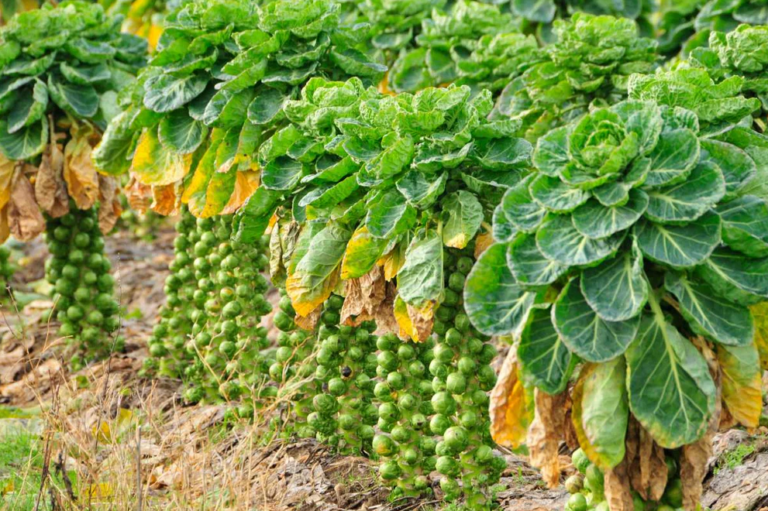Brussels sprouts, a member of the brassica family, are a great addition to any gardener’s plot. These miniature cabbage-like vegetables grow on tall, sturdy stalks, producing clusters of leafy, green sprouts.
Renowned for their nutty, slightly bitter flavor, Brussels sprouts are not only tasty but also packed with nutrients, making them a fantastic choice for health-conscious growers.
Cultivating Brussels sprouts requires patience and attention to detail, as they thrive in cooler climates and need a long growing season to develop fully. With proper care, including ample watering, pest management, and a keen eye on the weather, you can enjoy a bountiful crop of Brussels sprouts right from your own garden.
Care
- Water: Brussels sprouts need consistent moisture to thrive. For gardens with sandy soil, which drains quickly, it’s important to water your plants every three to four days. In contrast, if your soil is clay-based and retains moisture well, watering once a week should be sufficient. The key is to keep the soil evenly moist but not waterlogged.
- Light: Brussels sprouts prefer full sun and will do best in a location where they can receive at least six hours of sunlight daily. In areas with extremely hot summers, providing some afternoon shade can help prevent the plants from overheating and bolting.
- Soil: These plants thrive in rich, well-drained soil. Aim for a slightly acidic to neutral pH, around 6.5 to 7.0. Incorporate plenty of compost or well-rotted manure into the soil a few weeks before planting to enhance fertility and structure. Well-drained soil that retains moisture without becoming waterlogged is ideal.
- Temperature and Humidity: Brussels sprouts are cool-season vegetables and grow best in temperatures between 45 and 80°F (7 and 26,5°C). They can tolerate light frost, which can actually improve the flavor of the sprouts. Humidity is not a major concern, but ensure good air circulation to prevent fungal diseases.
Planting & Growing
Start by planting them 6-10 weeks before the first expected frost. Choose a sunny location with rich soil and sow seeds 3-4 inches apart, or space seedlings 18-24 inches apart. Maintain consistent moisture and begin fertilizing a month after planting. Keep an eye out for cabbage worms and treat them promptly. Harvest the sprouts when they reach 1-2 inches in diameter. For optimal growth, ensure soil temperatures are between 45 and 80°F. While they can be sown directly in mid to late summer for a fall harvest, starting with young plants can accelerate the process.
Pruning
Pruning Brussels sprouts is optional, but definitely encourages vigorous growth and more sprout development. Start trimming when at least one sprout appears, cutting off the lowest six to eight leaves close to the main stem. Continue removing two or three lower leaves weekly, keeping several upper leaves intact to nourish the plant. Three weeks before harvesting, stop trimming lower leaves and cut 1-2 inches off the top of the main stem to encourage uniform maturation. This technique, often used by commercial growers, helps produce a larger, more robust crop.
Common pests
Frequently Asked Questions
Do Brussels sprouts need full sun?
For healthy growth, brussels sprouts need full sun and nutrient-rich, consistently moist soil to thrive. Rotating their planting location annually helps prevent soil-borne diseases common to their family of plants.
How often should I water Brussels sprouts?
You should water Brussels sprouts weekly to keep the soil moist. Typically, they need about 1-2 inches of water per week, best by using drip irrigation.
Do brussel sprouts regrow after cutting?
Unless you cut off the top of the stalks, brussel sprouts should regrow and keep growing to about 2 to 3 feet tall.
What to plant next to Brussels sprouts?
Mustards, nightshades, Onions and Garlic are all great companion plants for Brussels Sprouts. Garlic and onions also have the advantage of strong scents that can shield your plants from pests like aphids.
